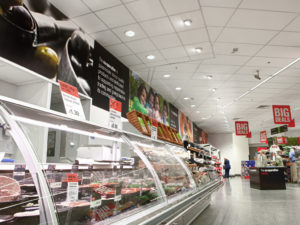
All kinds of factors can influence a customer’s decision to buy in-store and there’s increasing evidence that the lighting used in the building has a part to play.
This blog features five ‘make sures’ for retailers, giving you a checklist of the things you need to think about. Implement these lighting changes and you may be surprised how much difference it can have.
Like everything to do with technology, the pace of lighting innovation is faster than ever right now. LEDs give you more control in a range of different ways that enable you to make significant improvements to your overall solution.
One of the key benefits LED offers is the opportunity to control the correlated colour temperature (CCT) of your lighting. So what is CCT? Basically, it’s a scale that measures the exact shade of a white LED. As a retailer, you need to choose a colour temperature that is going to complement the items you’re selling. So, for example, crisp, cold, more blue-based lighting (and a high CCT) can feel very contemporary and work well with technology products like computers and sound systems. Warm yellow-based lighting (with a low CCT) is more appropriate for homely items like traditional furniture and soft furnishings.
Selecting a specific CCT is also a good way of optimising the appetite appeal of food, with the ideal colour temperature depending on the item. For displaying red meat, a warm white colour works best, whereas white fish looks freshest using cool white light. To bring out the natural bright colours of fruits and vegetables, the right level would be somewhere in between.

With the retail experience rising in importance for bricks and mortar stores, LED lighting can offer shoppers something they simply can’t find online. There are certain products that you need to see in the flesh to understand the subtleties in colour. High-quality lighting can bring items to life in a way that’s hard to achieve with a photo on the website.
Leading UK retailers, including Sainsbury’s and Marks and Spencer, are now using LED lighting in their stores and, while there are obviously other factors that may be involved, they have both benefitted from an increase in sales since installation. More concrete evidence comes from a study in the Netherlands which has found that intelligent lighting solutions have positively impacted sales by almost 2%. That can amount to a huge amount of money in the retail sector.
Lighting can have a powerful effect on the unconscious mind. Without your customers knowing it, you can use lighting design and colour temperatures to draw them into the parts of the store where you would most like them to be.
This can be achieved using clever contrasts in brightness combined with strong accent lighting and appropriate colour temperature choices. Get it right and you can tempt customers into the parts of the store that feature your best sellers. IKEA are masters of this, using lighting to lead you pied-piper style through the seemingly endless corridors of household items with a purpose.

The challenge is keeping the customer in your store for as long as possible. It’s much like trying to increase the dwell time of visitors on your website. In both cases, the longer you have their attention, the more chance there is that they will make a purchase.
Let’s start with your storefront. Make your window display as eye-catching as possible with accented light that can turn window shoppers into paying ones.
What will work best when customers step inside can depend a lot on the space you have to work with. Suspended high bay lighting is a good way of making high ceiling spaces feel smaller and more intimate.
Surface-mounted lighting, which can be fixed to walls and pillars gives you the option of low-profile lighting in selected spaces.
Your shelving displays are another consideration. Going for a wide-area backlight can be an effective way of catching the eye. Another trick you can try is using dynamic lighting on the lower shelves which can draw the eye of a browsing customer to an item that would otherwise be overlooked. Dynamic lighting mimics the fluctuations of sunlight throughout the day and works in sync with our natural body clocks.
Another huge benefit of LED lighting solutions is that they give you ultimate control. With wireless and Bluetooth technology and the Internet of Things, you can programme your lighting to subtly change throughout the day to create different moods and match the qualities of natural daylight. Or you can change the lighting in any particular area of the store at the touch of a button. This can help you direct the customer’s attention where you want it most, ultimately leading to an increase in sales.
Here’s a bonus tip: Make sure your lights and their controls are easy to reach for your workers in-store. This means they’ll have the flexibility to vary the lighting day-to-day to reflect the different emphasis that needs to be placed on different products with things like tactical promotions. This is a simple way of literally putting the products with the biggest margins in the spotlight.

Another of the big benefits of LED lighting is that it’s highly cost-efficient and will dramatically reduce your electricity bills. The fact is, LED lighting can reduce your energy bills by up to 75%. Take advantage of things like daylight harvesting, occupancy sensors and timers and you will be able to reduce bills even further.
There’s no denying that the appeal of older technology light fittings is the lower prices, but this is something of a false economy. They might be cheaper to buy but they still work out more expensive in the long run. In fact, invest in LED solutions and they can usually pay for themselves within a year through electricity savings alone.
It’s been well documented that some stores with traditional lighting have to keep their air conditioning turned up to the max throughout the year, due to the heat that’s being generated by their light fittings. That’s something you certainly don’t need to think about with LED. (Of course, being able to switch the air conditioning off comes with significant environmental, as well as financial, benefits.)
Due to the high lumen output per watt, LEDs are able to transform an impressive 70% of their energy into light. This makes them considerably more efficient than traditional light sources that waste up to 90% of their energy by turning it into heat. Further cost savings can be made with reduced maintenance charges since LED lights last 4 to 5 times longer than traditional solutions.
Hopefully, we’ve given you plenty to think about. If you’d like to discuss how Phi Lighting can help your business, please don’t hesitate to get in touch.
I can rely on Phi being proactive on issues arising.
Relationships & Empathy
Phi understands us, our scope and our limitations.
Relationships & Empathy
Phi delivers a good solution, which is more than just a product. Their service is good, they talk through schemes with us and there is more to it than just a catalogue.
Technical Skills
The main asset of Phi is people and the high level of technical backup they provide. For example with their competitors I meet a salesman and not a technical salesman. This difference is crucial.
Technical Skills
Good quality products at a reasonable price.
Price
Phi is not the cheapest supplier but they offer quality architectural fittings.
Price
Phi’s personal service is appreciated and differentiates them.
Service
During completed projects, we have been happy with the performance and communication from Phi. I can rely on Phi being proactive on issues arising.
Service
I see Phi for architectural led office foyers, reception areas, bespoke spaces in office blocks and good architectural lighting for commercial developments
Spaces
Appropriate for the commercial sector in particular and other places where there is a modern style requirement as befits their current product range.
Spaces
Phi is most suited to commercial offices, associated rooms and educational buildings.
Spaces
Phi delivers a good solution, which is more than just a product.
Perception & Image
We are project focused; there are lots of people in the industry but it is questionable whether they want to help and support properly. Why change to someone who may let you down, you stick with the best.
Perception & Image
Phi is not mainstream but a specialist niche architectural supplier who is a little bit different.
Perception & Image
Phi offer support, which sets them apart.
Perception & Image
Phi is a strong quality architectural supplier, giving good advice where we are lacking.
Perception & Image
Phi offer a great level of experience, supply, service and back up.
Perception & Image
I can rely on Phi being proactive on issues arising.
Relationships & Empathy
Phi understands us, our scope and our limitations.
Relationships & Empathy
Phi delivers a good solution, which is more than just a product. Their service is good, they talk through schemes with us and there is more to it than just a catalogue.
Technical Skills
The main asset of Phi is people and the high level of technical backup they provide. For example with their competitors I meet a salesman and not a technical salesman. This difference is crucial.
Technical Skills
Good quality products at a reasonable price.
Price
Phi is not the cheapest supplier but they offer quality architectural fittings.
Price
Phi’s personal service is appreciated and differentiates them.
Service
During completed projects, we have been happy with the performance and communication from Phi. I can rely on Phi being proactive on issues arising.
Service
I see Phi for architectural led office foyers, reception areas, bespoke spaces in office blocks and good architectural lighting for commercial developments
Spaces
Appropriate for the commercial sector in particular and other places where there is a modern style requirement as befits their current product range.
Spaces
Phi is most suited to commercial offices, associated rooms and educational buildings.
Spaces
Phi delivers a good solution, which is more than just a product.
Perception & Image
We are project focused; there are lots of people in the industry but it is questionable whether they want to help and support properly. Why change to someone who may let you down, you stick with the best.
Perception & Image
Phi is not mainstream but a specialist niche architectural supplier who is a little bit different.
Perception & Image
Phi offer support, which sets them apart.
Perception & Image
Phi is a strong quality architectural supplier, giving good advice where we are lacking.
Perception & Image
Phi offer a great level of experience, supply, service and back up.
Perception & Image
Phi Lighting Ltd
Unit 9, Brook Business Park, Brookhampton Lane, Kineton, CV35 0JA
Phone: +44 (0)1926 640 366Fax: +44 (0)1926 641 747Email: quotes@phi-lighting.com
Phone: +44 (0)203 875 6484
